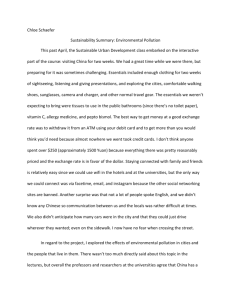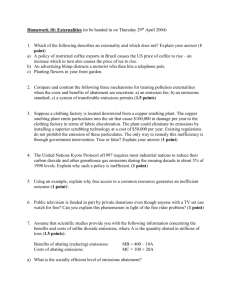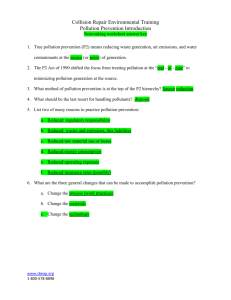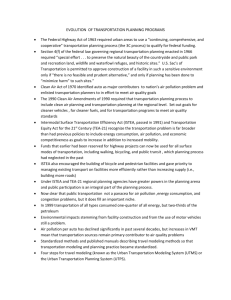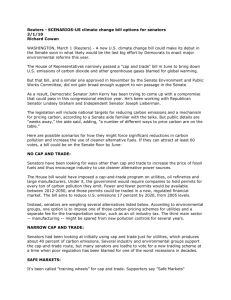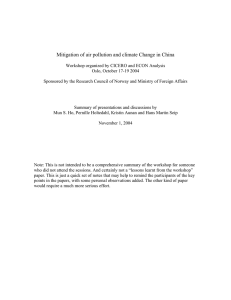DOC - Europa
advertisement
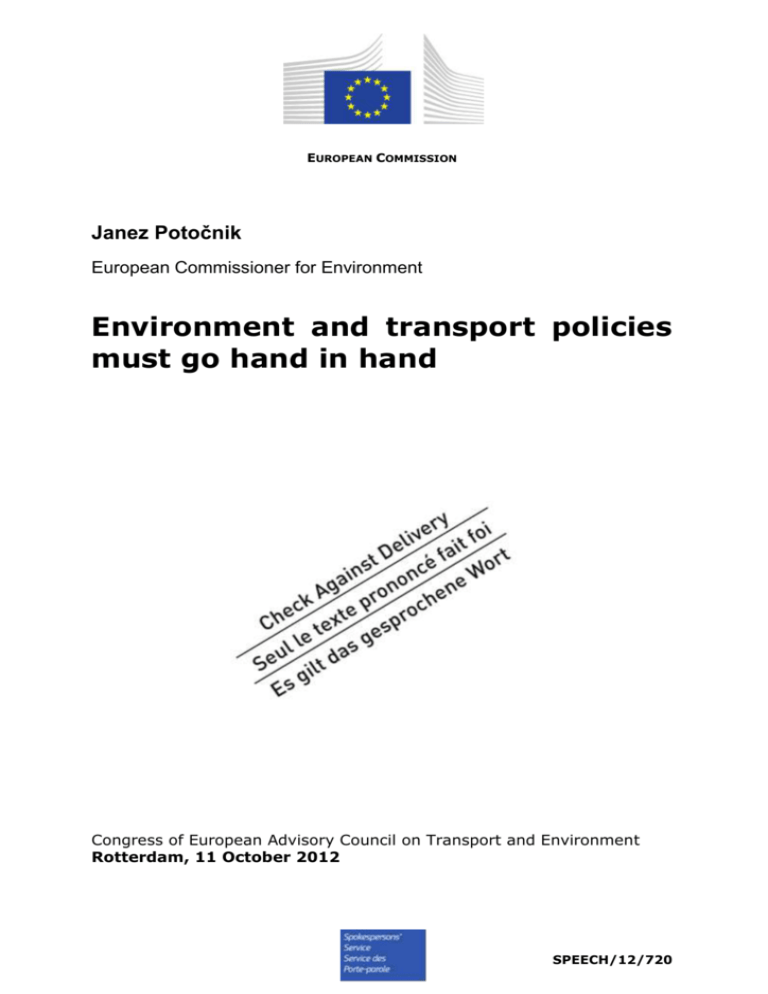
EUROPEAN COMMISSION Janez Potočnik European Commissioner for Environment Environment and transport policies must go hand in hand Congress of European Advisory Council on Transport and Environment Rotterdam, 11 October 2012 SPEECH/12/720 Ladies and gentlemen, Welcome to this year’s meeting of the Congress of European Advisory Council on Transport and Environment. It’s a real pleasure for me to be here. This is a very special venue and one most appropriate for this meeting. The SS Rotterdam is not only one of the most successful passenger ships of all times, but it is also one of the most environmentally friendly ships of all times. By using a shore side power-connection while at berth, the SS Rotterdam exceeds the environmental performance of almost all cruise ships in operation today. This magnificent royal ship is a brilliant example of how easily we can combine economic and environmental interests. If this was feasible more than fifty years ago, I am certain that with today’s knowledge and technology, we can do the same, if not better. And we should, because safeguarding the environment, is not only about the environment and its natural resources, it is also about our future, EU competitiveness, long-term prosperity, economic growth and job creation. Today, we are facing one of the most serious financial and economic crisis of our history. We are struggling to find our way out, to stabilise and reform our economies and to find effective ways to inject new growth and create new jobs. Long term financial consolidation is of course necessary, but in the European Commission we are also strongly supporting the renewed drive for sustainable growth, currently sweeping across Europe. In a century marked by resource scarcities, we need to look to the future and make sure that the decisions we take today will allow us to respond to the challenges of tomorrow … and this means defining new policies and moving towards a more sustainable growth model … one that takes into account the limits of our planet. The European Commission fully shares the underlying principle of the EEAC network – that current trends in production, consumption, trade and economic development are rooted in the unsustainable use of natural resources. This is why the “Roadmap to a single European transport area and towards a competitive and resource efficient transport system”, presented by the Commission in April 2011, places the accent on building a more competitive and sustainable transport system. The Roadmap outlines policy responses to some of the most urgent challenges the transport sector is confronted with, presenting 40 concrete initiatives for the next decade. The objective is to increase mobility, remove major barriers in key areas, and fuel growth and employment, while reducing Europe's dependence on imported oil and cutting carbon emissions by 60% by 2050. Key goals that go in this direction will include: No more conventionally-fuelled cars in cities with a shift to electric, hydrogen and hybrid cars. 40% use of sustainable low carbon fuels in aviation by the introduction of cleaner engines, design and shift to sustainable fuels; A reduction of at least 40% in shipping emissions through operational and technical measures, including new vessel design, and low-carbon fuels. And a 50% shift of medium distance intercity passenger and freight journeys from road to rail and waterborne transport. In addition, the Roadmap also looks beyond the sectorial aspects and aims to create seamless transport chains for passengers and cargo across modes, in particular by better integrating waterborne transport into multi-modal logistics chains. *** 2 Ladies and gentlemen, A shift towards a more sustainable transport system is very important, not only in response to increased resource scarcities, but also in response to the impact of transport on our health and the environment. One area where this is particularly visible is “air”. We have made significant progress in recent years in reducing the air pollution impact of transport and in improving air quality in the EU. The use of cleaner fuels by ships in and outside ports, and the use of shore side electricity while at berth, are among the many incremental steps recently introduced in legislative and other EU initiatives. These will contribute to improving the quality of the air we breathe compared to 20 or 30 years ago. But, despite these important achievements, it is forecast that there will be over 200,000 premature deaths every year due to air pollution by 2020. We are still some way from achieving our objective of no significant negative impacts of air pollution on human health and the environment. This is why, I have launched a comprehensive review of the EU air legislation and declared 2013 the European “Year of Air”. The objective is to close existing gaps in our legislation and to raise awareness on the importance of our daily choices, in particular in relation to transport, and the impact these have on our health and well-being. Allow me to briefly outline some key elements I will attach particular importance to: Protect public health. In this we are closely cooperating with the World Health Organisation to review the latest scientific evidence on the health impacts of all pollutants regulated under EU legislation, along with an evaluation of emerging risks to health from air pollution. Protect our natural capital and promote a more sustainable agriculture. The National Emissions Ceilings Directive, adopted in 2001, provides one of the backbones of EU air legislation by effectively capping emissions of key air pollutants – sulphur dioxide, nitrogen oxides, volatile organic compounds, and ammonia. Better implementation of EU environmental legislation. We will ensure that EU legislation is fully implemented and that Member States respect the limit values for Particulate Matter, Nitrogen Dioxide and other pollutants. But at the same time, we will also help regions and cities in developing their air quality plans by spreading best practices. Promote innovation for sustainable growth. Some still argue that in times of severe economic hardship, air pollution measures are too costly. I would argue that air pollution itself imposes much greater costs on the economy. In monetary terms, the estimated costs associated with air pollution are in the range of €189 - €609 billion per year in 2020. Those who argue that it would be too costly are on weak ground even from a strict competiveness perspective. Let us put aside all the health and environmental benefits for a moment –important as they are – and look instead at the economic arguments: Let's take the US and China as examples. 3 We know that the US air quality legislation and transport emission limits are among the most stringent in the world – with California leading the way. We also know that China is now stepping up its air quality monitoring requirements and emission controls significantly. And we know that other emerging economies will follow suit. This will create an enormous demand for products and industrial processes that emit less. So a strengthened air quality and sustainable transport regime in the EU will actually benefit European competitiveness by giving us a lead in these growing markets. Sustainable mobility is therefore not only an environmental objective, but also an economic opportunity. And last but not least, encourage innovation and address emissions at source. Industry, transport, energy production, agriculture and household consumption are important engines of growth and prosperity. To focus on transport, as a result of the EU-wide provisions called Euro standards, industry has innovated to cut emissions from vehicles, but there are still areas of concern, such as for example the high NOx emissions from diesel vehicles. I expect these to be addressed when the new Euro 6 standards enter into force in 2014, but they will be only in part. I am also even more concerned about the gap between tests set in the “type approval regulation” and “real world” emissions in practice. This is why we need to ensure that air quality and transport policies go hand-in-hand. We will also encourage and support innovation through better emission standards for off-road vehicles and machineries, as well as through better performing mobility systems in general. E-cars and bikes, for example, bring new options to the table. The backbone of Europe, the new Trans-European transport network, will be a "Strategic Environmental Assessment-based" transport network. During a very successful event, the TEN-T Days, one of the presented successful projects on the implementation of Natura 2000 and TEN-T was also "Maasvlakte 2, A sustainable expansion of the Port of Rotterdam." Finally, let me stress that the proposed Connecting Europe Facility and its € 31.7 billion (€ 10 billion earmarked from the Cohesion Fund) is the guarantee that necessary infrastructure investments of high EU added value will be realized. It is therefore also the guarantee that the critical transport infrastructure needed to spur economic growth and ensure cleaner transport will be realized thanks to the strong European prioritization and funding. *** Ladies and gentlemen, This forum brings together highly renowned experts and scientists with a wide spectrum of expertise ranging from technical disciplines to philanthropy. Your advice will be important in steering policy through the troubled waters of the current economic situation. I hope I can count on your support to ensure that recovery is based on the principle of sustainable growth. Let me conclude by thanking the organizers of this conference for putting sustainable transport high on the agenda, for preparing a fascinating program and for attracting world class speakers. I wish this conference every success. 4

